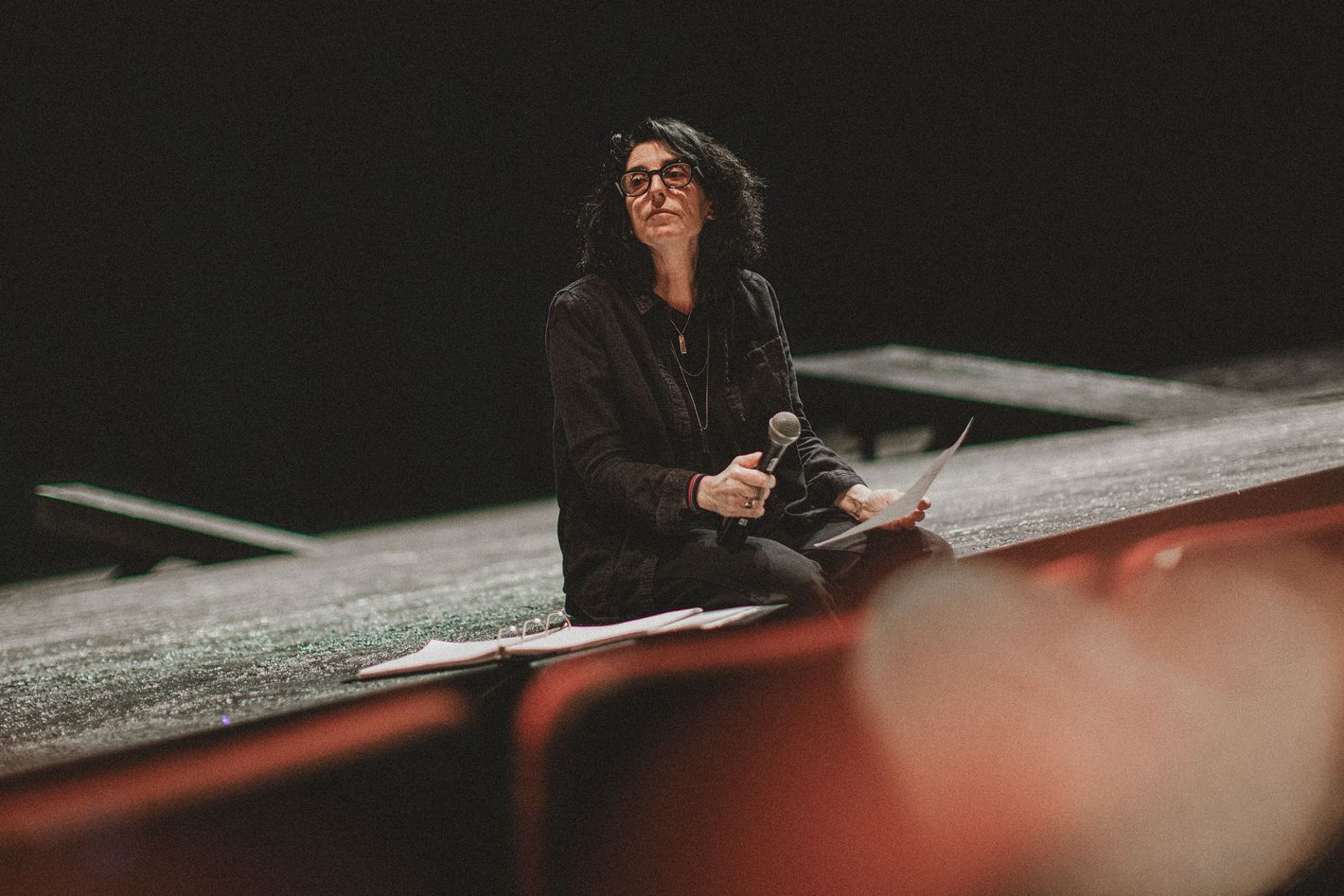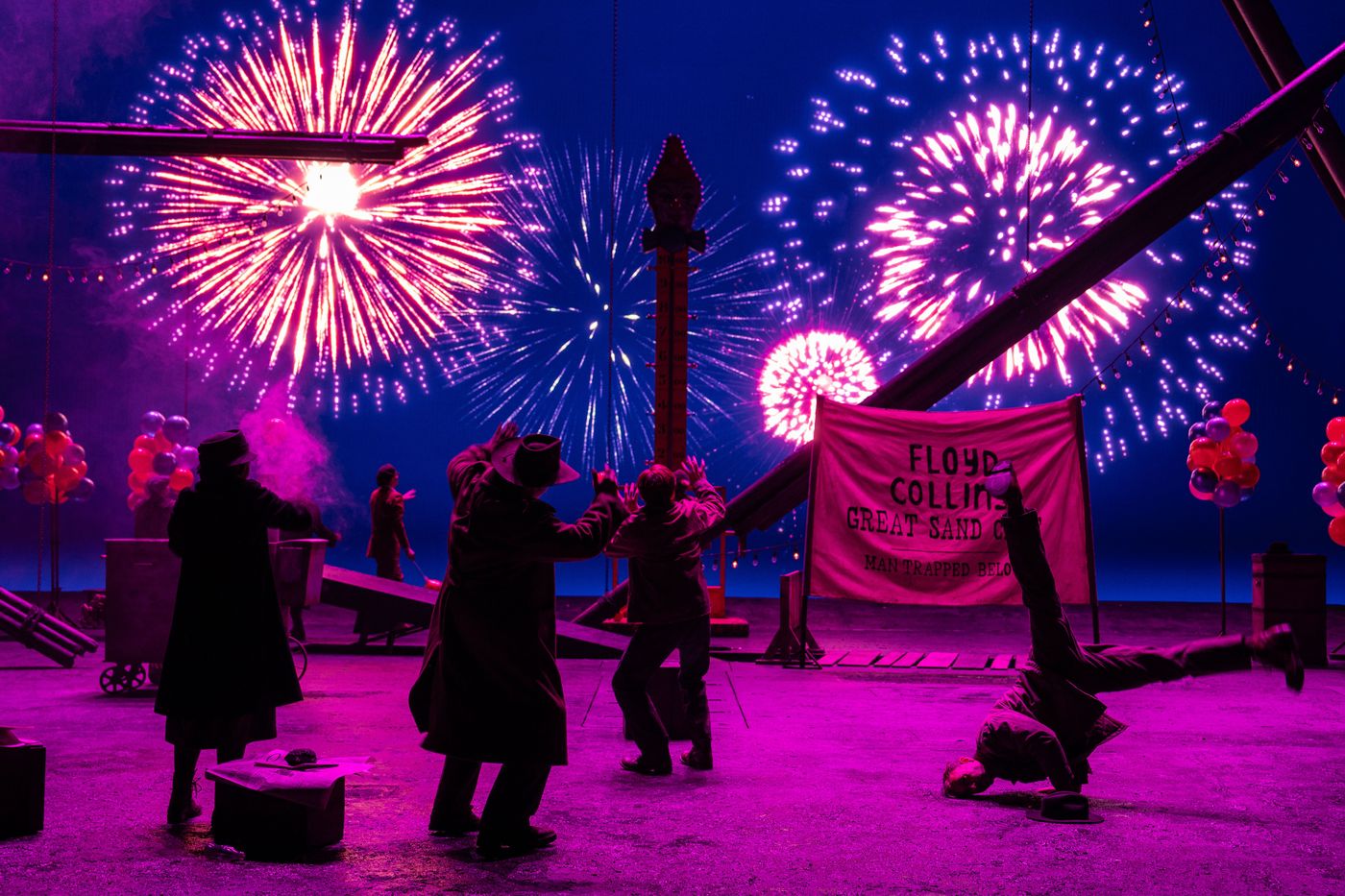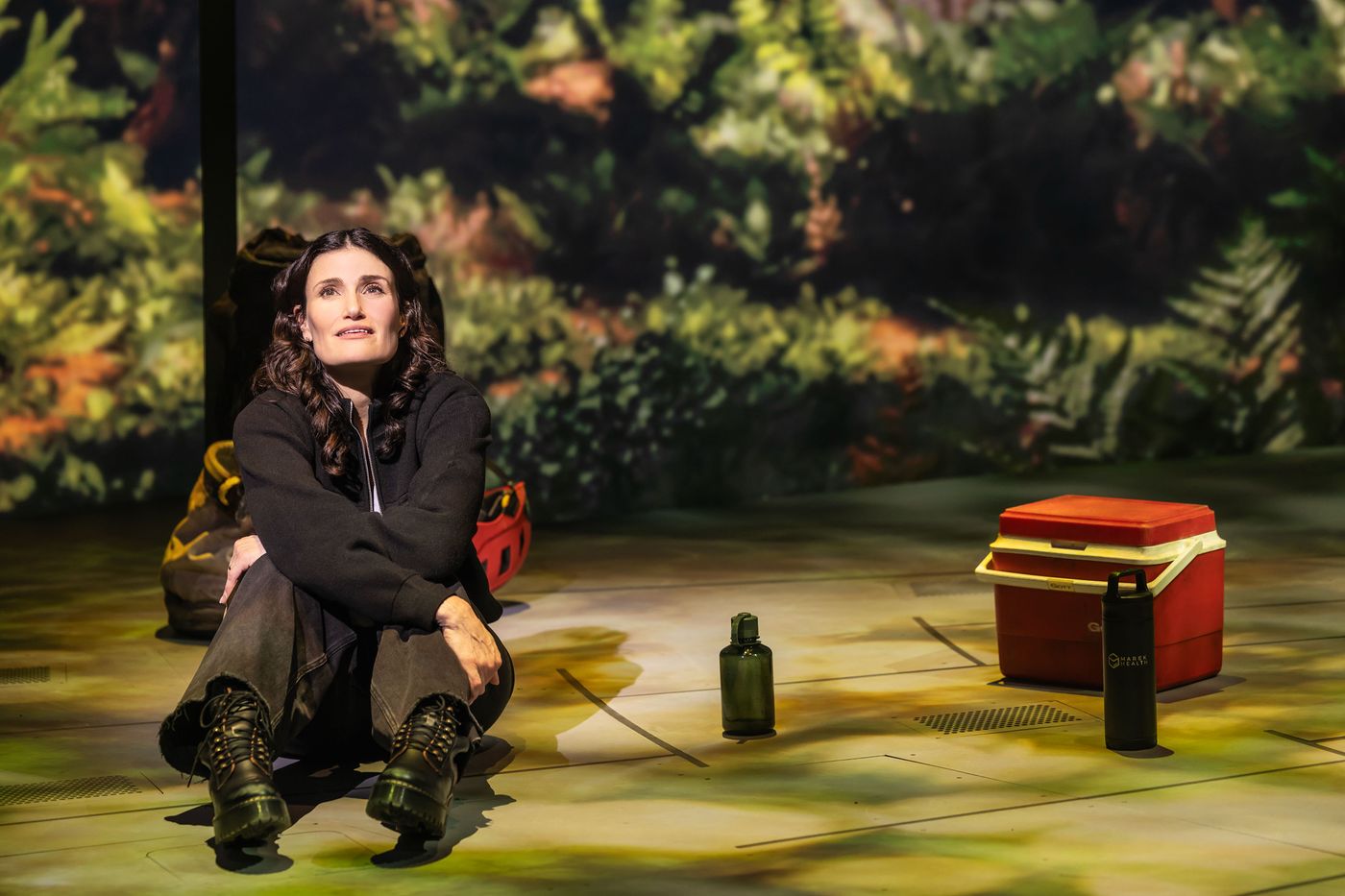

In the semi-twilight of tech rehearsal at the cavernous Vivian Beaumont Theater at Lincoln Center, Tina Landau is scrutinizing the movement of lanterns. Unassuming in a flannel shirt and beanie, the director’s watching her ensemble work through a scene change of Floyd Collins, the musical she wrote three decades ago with composer Adam Guettel about the Kentucky explorer who became trapped in a cave and inspired a 1920s media circus. The show had a brief run Off Broadway in 1996, then lived on with a miniature national tour and a beloved cast recording. It’s been produced around the country and internationally since but not again in New York City until now. On this March afternoon, it’s still becoming what it will be on Broadway: Crew members come up to Landau to discuss the process of making the floor resemble real dirt and mud, whether a test-your-strength carnival machine can be struck in time with the music, as well as drafts of a digital rendering of the sky that will grace the LED screen at the back of the stage. “The thing I’ve known about this show from the beginning,” she tells me, “is the more we try to be literal, the less it works.” Floyd spends most of the action stuck underground, a predicament rendered figuratively by having the actor Jeremy Jordan confined to a chaise longue–esque construction integrated into the rest of the rocky stage.
Landau starts thinking about how the ensemble will navigate a change into another scene at the encampment that has sprung up around Floyd’s entrapment. “The last time we did this transition, it felt a little transition-y,” she announces through a mic, “as opposed to seeing the meaning of these characters moving through the space, being purposeful. We want to watch a passage of time at the site.” As a director, Landau is known for her work with space — she’s co-written a book on the theory of Viewpoints, a movement-based theatrical practice — though she’s also taken the helm of big Broadway musicals. Landau brought SpongeBob to Broadway, and earned a Tony nomination, while she’s also directed regularly at Steppenwolf. “For years, I felt I had a split personality,” she says, “And I’m a Gemini, so it was appropriate.”
This spring, Landau is taking on two musicals at once and has written the book for both. Just days before jumping into rehearsal for Floyd Collins, which opens on April 21, she debuted Redwood, starring Idina Menzel, a semi-autobiographical piece about a woman who works through a personal tragedy by finding herself in the California forest. Landau discovered the shows speak to each other in surprising ways. One goes up to the canopy; the other down to the depths. Both reckon with loneliness and connection. Landau’s still putting together the links and disjunctions.
There hasn’t been a revival of Floyd Collins in New York since its premiere in 1996 because you and Adam held on to the rights. What was it about this show that made you so certain you wanted to return to it?
The original run at Playwrights Horizons was so short. We were fortunate in 1999 to do a small national tour, and we rewrote some of it and added a new song, but we ended that feeling like we weren’t done yet. From early on, talk of Lincoln Center came up and I had this image of doing the show at this theater. We spoke with artistic director André Bishop about it over the years, but Adam in particular wanted to make sure he had other shows in place before he went back to Floyd. We did get a lot of offers from other people who wanted to direct it, but Adam was great in that he said, “No, it’s Tina’s show.” It hasn’t been vastly done elsewhere, but it has over the decades developed a cult following.
You must have also been in the middle of developing Redwood when the offer for Floyd came up.
I remember the moment we got word that André wanted to schedule Floyd for his final production and getting word the very same week that we had a theater for Redwood. When I first got the two schedules, they opened the same week. I fought for four days off between Redwood opening and the start of Floyd.
With Redwood, you built the show with a star in Idina Menzel, so that was set from the start. What were you looking for in casting Floyd?
Casting took awhile, and it became clear when we started that the role of Floyd was more demanding than even we had remembered. You need a serious, nuanced, deep, and funny actor, and the vocal demands are through the roof. There are not many people who could sing it, so I thank my lucky stars every day that it’s Jeremy Jordan. I didn’t know at the time what the physical demands were going to entail. The opening number, “The Call,” involves a lot of climbing and sliding and acrobatics and descending a rope. Jeremy’s a monkey. He will climb on and through anything — he’s like Floyd.
When you’re staging the show now, how much does your original version of it stick in your, I guess, spatial memory?
There were certain key approaches that were part of the original production that I knew from the beginning were going to come alive again. I had an idea about bodies and silhouettes against the sky, and I knew I was keeping that. And there’s a sequence toward the end called “The Dream” in which the cast emerges in all white. There were also things that were a little broken and needed to be improved. In the first version, we were determined to get every nuance and piece of research we had done into it. The script as it’s written is in the way some of those old-fashioned Rodgers and Hammersteins are where the dialect is written in. It’s very idiom-heavy. I’ve done a whole pass on the script to streamline and not have that stuff get in the way.
But we also did things in the original writing and the structure because we were in our 20s, knew no better, and didn’t care what anyone thought. Today, both of us feel like, Would we be as brave now? We decided to open a show with a 14-minute number of a man climbing solo into a cave. What were we thinking?

Redwood is also about an individual going off into nature, and in SpongeBob as in Floyd, there’s a send-up of a media circus. How conscious are you of these sorts of recurring themes?
My passion takes me, stylistically, in very different directions, but there are a lot of core themes and echoes. My body of work has been a surprising mirror back to myself. The main pattern I recognized, years and years ago, was that I was always telling in some form the story of an outsider, an individual and their relationship to society — both the loneliness and the freedom of that journey. I guess I have felt that way my whole life. When I went to preschool, I sat in a corner and drew on paper and would not talk to the other kids. My parents thought there was something amiss, but the doctor said there was “nothing wrong with Tina. She is creating the world she wants to be in.” By age 6, I was putting on shows in the basement. I was walking around saying I wanted to be a director. I don’t know where that came from.
Your parents were movie producers, so you must at least have heard of directing as a profession.
And we did go to the theater all the time. I grew up on Broadway musicals, and it wasn’t until my teenage years and in undergrad at Yale that I steeped myself in more avant-garde or experimental theater. Half of me was Broadway musicals, and half of me was this weird other stuff. It took me a very long time to realize they could meet and be happy together. In college and high school, I directed The Music Man and I directed Guys and Dolls. I don’t remember the concept for The Music Man exactly, but it had something to do with Harold Hill being out of the story in a Brechtian way and constructing the story for us. It was something like that.
And you directed a revival of Bells Are Ringing on Broadway in 2001, though I’ve read you say you regretted compromising your vision on that.
I had a very clear and strong idea when I went into it that gradually got watered down because I was young and trying to please legends of the business. In retrospect I wish I hadn’t done that, but it was all part of my learning and growing.
You’ve been a member of Steppenwolf since 1997, which, from what I understand, had reached out because of an interest in doing Floyd Collins.
Frank Galati, the director, came to see Floyd at Playwrights and then called the artistic director Martha Lavey and said, “We have to do this musical at Steppenwolf.” We talked about it and it became clear to me that Steppenwolf at the time wasn’t equipped to do a musical like this, especially since it wanted to, as always, cast ensemble members and it didn’t have the group to perform and sing this particular musical. But Martha and I started speaking about what else I could do.
It had, especially then, a reputation for doing realist drama, which isn’t necessarily your stock and trade.
My first show at Steppenwolf was a Chuck Mee play called Time to Burn and it wasn’t straight-up naturalism, but there were naturalistic elements to it. I remember thinking it might be a disaster because I’m going to be in a room with people who want to act around the kitchen sink and hit baseball bats and know what their motivation is, and I’m bringing in this movement technique that I practice, teach, and write about called Viewpoints. It’s not instead of working from the inside out, but it is in addition to that — there are ways we can listen to and work with our bodies to create movement onstage. But I’ll never forget our first Viewpoints session, when I said to the company to give me two hours of an open heart. There was an amazing Chicago actor named Mike Nussbaum who was in the show and he raised his hand and said, “I learned something today.” I was like, Oh no. He said, “You can teach an old dog new tricks.” I was talking with another ensemble member about Viewpoints and other acting techniques, and what Steppenwolf aspired to and what Viewpoints aspired to were the same values. They’re about being bold, spontaneous, and the ultimate goal’s the same as Meisner or Stanislavski. It’s just a variety of ways to get there.
What does it look like when you introduce Viewpoints in a rehearsal room?
I definitely take a certain amount of prescribed time to explain what the Viewpoints are and individually introduce them and practice them. Then the hope is that over time the company starts integrating that into their work and the performance in an unselfconscious way. I feel like that’s where we’ve gotten with the Floyd company. I always say that part of the deal is that we’re applying a language to the things actors do organically. If there’s a lot of people onstage at Floyd, sometimes, instead of having to say, “Jack, move stage right two feet. Sally, come down one foot.” I can say, “Spatial Relationship,” which is one of the Viewpoints, and you can see the whole cast adjust and reconfigure based on their spatial relationship to each other.
You could see a lot of that at work in SpongeBob, which to me melded experimentation with this big commercial property. What did it feel like to have that come into New York in 2017 and get this great critical reception?
It was freeing and joyous and less about the critical reception. I would go back to the show regularly to watch the audiences’ experience of glee. SpongeBob was fantastic because it had real development time. Nickelodeon and our producers put their money where their mouth is in terms of “this is not a cash cow. This is something we are developing artistically.” Every workshop we did, and we did a lot of them, was focused on a very particular element of the show. What does it mean to have a cartoon character walk onstage? What is the music? It was over ten years that we worked on it at least once a year.
You got a Tony nomination for SpongeBob, and I can imagine other producers coming in with offers to do similar work. Did it feel like a change in the profile of your career?
Sometimes I think, Well, if I just did that other musical I didn’t connect to, I’d have a bigger, more lucrative career. But I’ve never been able to do that. When I’ve done projects I haven’t felt the deep reason for doing, I have gotten sick and I quit them.
Physically sick?
That happened early on in my career. Two or three shows I had to leave. I’m no good at working at something that doesn’t feel true and meaningful to me. So I don’t remember if there were more offers, but I’m so picky it didn’t feel like a huge difference. I maybe just said no a little more. Plus there was the pandemic. Anything that might have been cooking just stopped.
It was then that you and Idina started talking more seriously about Redwood.
We met around the time of Rent and Floyd Collins, which were the same season. I was close with Jonathan Larson, and I was there the night they performed after he passed away. After that, I auditioned Idina once or twice, and she says that when she first came to me with the idea of writing something about someone in a tree, that was partially because of Floyd. She was like, Well, Tina knew how to write a show about someone in one place. By the pandemic there were shards of ideas, but when we reunited we both agreed that we were no longer interested in those shards. We went in search of a new show, and emblazoned inside of us was this crystal-clear image of a woman sitting in a tree. We were both interested in why that mattered to us, trying to get to the bottom of that.

This came up in some of the reviews of Redwood, but while the show’s about a person’s connection to the environment, it’s not about climate change or activism. She goes on an interior journey, processing her grief over a personal loss. Was that intentional?
Yes, and I think that was part of our change from our early musings, which were about a more historical story about lumber companies and tree logging. When we came back together, we were both more interested in a more personal story. We didn’t know if it was going to be a one-person show or a concert or an installation piece with Idina singing in the middle of it, and it slowly turned into something that is a little bit of all those things. But yes, it’s the story of a woman’s transformation more than someone learning about …
Look, I’ll be candid and say it: I was hurt by a lot of the reviews. I can’t argue with anyone’s experience or taste and I would never want to. There are people who loved it and really loved it, and there are people who really just say it’s bad. That was surprising to me. In some cases, I feel like my intentions were just somehow not translated clearly, or somehow those people didn’t get what I thought I was doing.
You didn’t expect that range of enmity or love?
No. And I get a lot of mail, more than I ever have, about that show. People are deeply moved by some aspect of it and sometimes seemingly oblivious to other aspects of it. It’s really about the environment or it’s really about grief or it’s really about escaping urban life. I guess that’s a good thing that people find in it some reflection of what they want and need that story to be. But it’s been surprising.
Was there a specific intention you felt that people were missing or misinterpreting?
No, not in general. I might have felt that way at the beginning, but since then I have gotten so much direct feedback from audiences and strangers and people I know who have deeply gotten what I intended. I feel very gratified and at peace with that part of it.
You’ve talked about how there’s a lot of you in the character of Jesse. She’s a queer woman. Your nephew’s overdose inspired part of the plot. That must add an extra layer of investment.
I’ve never done a show that’s anywhere near directly as personal as Redwood. When you open yourself up, things that aren’t the most positive sting in a different way. I’m pretty resilient about reviews. I do read them all. With this piece, I understood what other writers have told me, which is that your logical brain may know it’s not personal, but when your soul and family is in there in a direct way, it can hurt. I really am at peace with it, but that was a new experience for me.
What motivated you to include that part of your own story in the piece?
I lost my nephew at the beginning of the pandemic and without thought, but out of necessity, that became the subject. What I wanted to write about was that grief that I was in and the solace I found in the trees around me near my home. It was a bit like Floyd at its beginning where I didn’t second-guess it. I didn’t think about whether it was a wise move or not. It just felt like what poured out of me.
Were you into hiking as a kid? What gave you this love of trees?
No, and I don’t know. I think trees, for me, represented escape. It’s that childhood fantasy that many people share of climbing up into a tree and disappearing into another world. That’s not that different from being a little girl sitting in a corner drawing. It was a way of going somewhere and inventing my own reality. Later in life, I started experiencing the Redwoods. My first trip was to Muir Woods. I was in San Francisco and looking for something to do on my day off and I was staggered. I had that experience of silent awe when you look at the sky on a particularly starry night. It makes you small but in the way of being part of something larger than you fully understand.
In Redwood, Jesse reconnects with her Judaism, and in Floyd Collins, there’s so much questioning of God and the afterlife. How do you see faith playing into those shows? [Spoiler alert: We discuss the endings of both musicals going forward. Floyd Collins’s is historical fact, but fair warning.]
Going into the last song Floyd says, “Faith is believing in something you can’t see. I’ve had faith all my life.” For both characters, it’s really about surrender to what one might call a higher power, or the universe, or the truth of life, which is death. Jesse doesn’t die, but her final act is one of surrendering to something that she has been avoiding and is not given into and has tried to control. That’s very much what the sense of faith is in both of those shows. It’s not specifically about this or that God, Judaism, or Christianity.
One ends with death, while the other with reintegration.
Well, to me, both have a happy ending. I felt that in auditions for Floyd Collins when people kept coming in and singing “How Glory Goes.” Someone dies. But there’s a kind of peace, joy, and freedom. Floyd goes up to the sky. Jesse goes back to her life, but I think they’re both moments of transformation and release.
Floyd Collins opens on April 21 at the Vivian Beaumont Theater at Lincoln Center; Redwood is at the Nederlander Theatre.

Latest News
For Sale! 2016 Sea Ray 350 Sundancer – $180,000
Reel Deal Yacht is pleased to feature a meticulously maintained 2016 Sea...
Customs Confiscates Almost 2,000 Counterfeit Van Cleef & Arpels Jewelry Items
El Paso’s Battle Against Counterfeit Luxury Goods: A Recent Seizure by CBP...
Tyler Glasnow is the latest Dodgers starting pitcher to hit the injured list
Right-hander Tyler Glasnow has been placed on the 15-day injured list by...
Cavs win by 55 points to sweep Heat and finish off most lopsided series in NBA playoff history
Cleveland moved into Round 2 with the most lopsided series win in...
Celtics, Knicks, Pacers can advance Tuesday in Game 5s, but Nuggets-Clippers is too close to call
The Boston Celtics, New York Knicks and Indiana Pacers are on the...














Leave a comment